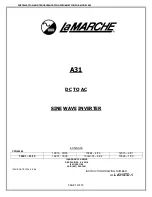
8
Operation
The Flying Calf is compatible with 20-bit, 18-bit and even 16-bit
S/PDIF data. The more bits per data word, the better the dynam-
ic range of the output signal and better dynamic range equates to
better audio quality.
When a valid signal is present at the Flying Calf's S/PDIF In jack,
the Calf automatically detects the S/PDIF sample rate and syn-
chronizes to it. Once locked to the sample rate, the front panel
"Data Valid" LED will light.
REMEMBER: The Flying Calf accepts any sample rate that is 50
kHz or less.
The Flying Calf then decodes the S/PDIF data to a format recog-
nized by the Calf's D/A converter. The D/A converter then out-
puts stereo analog audio to the internal output amplifiers. The
left channel output amplifier drives unbalanced audio to Left
Analog Out jack, and the right channel output amplifier drives
unbalanced audio to Right Analog Out jack.
The analog outputs of the Flying Calf provide line-level audio sig-
nals typical of most consumer audio components. The output
level is adjustable, however, and may be set for less gain (6 dB
less) by moving two internal jumpers within the Flying Calf. To
do this, 1.) remove power from the Flying Calf and disconnect all
external cables, 2.) carefully remove the Flying Calf chassis cover
by removing the 4 screws from the sides of the chassis, 3.) locate
jumpers JP1 and JP2 on the Flying Calf's circuit board, 4.) posi-
tion JP1 and JP2 as shown in the diagram below, 5.) replace the
Flying Calf chassis cover and screws.






























